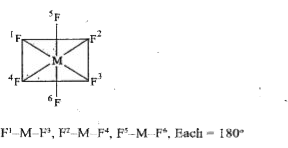In a regular octahedral molecule SF6 the number of F-S-F bonds at 180∘ is Solution in Malayalam
The correct Answer is:3
Topper's Solved these Questions
- CHEMICAL BONDINGBOOK - BRILLIANT PUBLICATIONCHAPTER - CHEMICAL BONDINGEXERCISE - LEVEL-III ( Matching Column Type )
5 Videos
- CHEMICAL BONDINGBOOK - BRILLIANT PUBLICATIONCHAPTER - CHEMICAL BONDINGEXERCISE - LEVEL-III ( Satement Type )
5 Videos
- CHEMICAL BONDINGBOOK - BRILLIANT PUBLICATIONCHAPTER - CHEMICAL BONDINGEXERCISE - LEVEL-III (Multiple Correct Answer Type )
12 Videos
- CHEMICAL AND IONIC EQUILIBRIUMBOOK - BRILLIANT PUBLICATIONCHAPTER - CHEMICAL AND IONIC EQUILIBRIUMEXERCISE - Level - III (Linked Comprehension Type Questions)
1 Videos
- CHEMICAL BONDING AND MOLECULAR STRUCTUREBOOK - BRILLIANT PUBLICATIONCHAPTER - CHEMICAL BONDING AND MOLECULAR STRUCTUREEXERCISE - QUESTION (LEVEL -ll)
42 Videos
Similar Questions

View SolutionIn the following question, an Assertion (A) is followed by a corresponding Reason (R). Use the following keys to choose the appropriate answer.
Assertion : In case of (CH3)3N geometry is pyramidal, but in case of (SiH3)3N it is planar.
Reason : The maximum covalency of Si is six but that of C is four. : If both (A) and (R) are correct and (R) is the correct explanation of (A)., If both (A) and (R) are correct, but (R) is not the correct explanation of (A)., If (A) is correct, but (R) is incorrect., If both (A) and (R) are incorrect.
View SolutionThe planar shape of N(SiH3)3 is explained by the
View SolutionThe degre of dissociation of weak electrolyte is inversely proportional to the same square root of concentration. What is called Ostwald's dilution law.
α=√Kac As the temperature increases, degree of dissociation will increase.
α1α2=√Ka1Ka2 if concentration is same. α1α2=√c2c1 if acid is sam.
For two monobasic acids HA1 and HA2 at the same concentration α1 and α2 are in ratio of 1:2. Ka1=2×10−4. What will be Ka2 ? 8×10−4, 2×10−4, 4×10−4, 1×10−4
View SolutionWhich of the following species are hypervalent ?
(l) ClO−4
(ll) BF3
(lll) SO2−4
(lV) CO2−3
View SolutionIn a regular octahedral molecule SF_(6) the number of F-M-F bonds at 180^(@) is .
View SolutionIn a regular octahedral molecule MX6 the number of X−M−X bonds at 180∘ is
View SolutionIn a regular octahedral molecule MX6 the number of X−M−X bonds at 180∘ is
View SolutionF-S-F bond angles in SF_(6) molecule are _________.
View SolutionAssertion. All F-S-F bond angles in SF_(4) are greater than 90^(@) but less than 180^(@) Reason. The lone pair-bond pair repulsion is weaker than bond pair-bond pair repulsion.
View SolutionIn a regular octahedral molecule, MX_(6) the number of X-M-X bonds with 180^(@) is-
View SolutionSF_(6) Molecule contains " 2x " " F-S-F " bond angles equal to 90^(@) each.What is the value of x ?
View SolutionMX6 , अष्टफलकीय अणु में, 180∘ पर X- M -X बन्धों की संख्या होगी
View SolutionMX6 , अष्टफलकीय अणु में, 180∘ पर X- M -X बन्धों की संख्या होगी
View SolutionMaximum number of planar atoms in SF_6 molecule
View SolutionFind average bond energy of S-F in SF6 (in KJ/mole) using following data
ΔH∘f(SF6(g)) = -1100Kj/mole, ΔH∘f(S(g)) = 285Kj/mole, ΔH∘f(F(g)) = 80Kj/mole
View Solution

